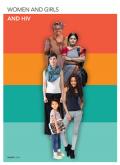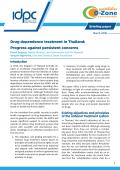What's New
Displaying results 1561 - 1570 of 4913

Resource | Infographics,
We know that through enabling women and girls to fulfill their rights to health, to education and to self-determination, change happens. Good health enables women and girls to thrive, to grow, to explore and to contribute to their communities. Access to quality health services and learning how to stay healthy enables women and girls to prevent illness, including HIV, and to exercise their sexual and reproductive health and rights.
We cannot stand by and allow the quality of life of women and girls to be held back and their hopes and dreams for the future to slip away. We must work collectively to close the gaps that continue to leave women and girls behind. Ending the AIDS epidemic by 2030 depends on advancing a social justice agenda that demands access to education, employment, health services, justice and political representation, free from discrimination and violence.

Resource | Publications,
UNAIDS has been at the leading edge of progress on gender in the UN. In just four years, UNAIDS has transformed its leadership at the country level from 27–48% women (2013–2017).

Resource | Publications,
Population aged 60 years and above for the year 2017 is represented with 9.0% of total population in which 4.3% and 4.7% are made up of male and female population respectively.
On the residential status, the share of the Brunei Citizens was around 76.8%, Permanent Residents 7.8% and temporary Resident 15.4%. As is the case of affluent countries with small populations, the foreign proportion of the population is rather high. The relatively high number of forign population is being contributed by the number of working immigrants.

Resource | Fact Sheets,
In 2016, the Kingdom of Thailand formally decided to re-allocate responsibility for drug dependence treatment from the Ministry of Justice to the Ministry of Public Health by the end of 2018.
This paper offers a brief analysis of these two challenges in light of current policies and practices, along with recommendations for overcoming them to ensure the implementation of a drug treatment system that can result in improved health and human rights outcomes for people who use drugs and people dependent on drugs.

Resource | Publications,
The report is released ahead of regional meetings commencing this month in preparation of the annual High-Level Political Forum on Sustainable Development. The report calls upon UN agencies, Member States, and members of civil society to collaboratively ensure HIV-related data is included in the framework of Agenda 2030.

Resource | Publications,
This report updates the first edition, published in 2016, and reviews the progress countries have made in expanding access to life-saving DAAs. The report reviews the main challenges countries face and describes recent developments in relation to five key factors that determine access to DAA medicines: affordability, quality assurance, regulatory approval, government commitment and financing. It highlights key areas for action by ministries of health and other government decision-makers, pharmaceutical manufacturers and technical partners.

Resource | Fact Sheets,
In March 2018, there were 912 new HIV antibody seropositive individuals reported to the HIV/AIDS and ART Registry of the Philippines (HARP) [Table 1]. Sixteen percent (148) had clinical manifestations of advanced HIV infection (WHO clinical stage 3 or 4) at the time of diagnosis.

Resource | Publications,
At the 2011 United Nations General Assembly High-Level Meeting on AIDS that took place in June in New York, Member States adopted a new Political Declaration which contained new targets to effectively respond to the AIDS epidemic. The 2011 Political Declaration mandates UNAIDS to support countries in reporting back on progress made towards achieving the new commitments. It also provides for the UN Secretary-General to report regularly to the General Assembly on progress achieved in realizing these commitments.
Nepal’s HIV epidemic remains concentrated among key populations, with HIV prevalence at 5% among MSM and 8.5% among TG people in certain parts of the country; 8.8% among males who inject drugs and 8.8% among women who inject as well; 2.2% among FSW; and 0.4% among MLM. The majority of new infections are occurring among ‘low risk’ women infected by from their spouses, male labour migrants and MSM.

Resource | Publications,
This report highlights the findings from a seven country study of stigma and discrimination in the Pacific region funded by the Global Fund through the UNDP Pacific Office in Fiji. The report will also give recommendations for how stigma and discrimination can be reduced and ultimately eliminated in the region in line with UNAIDS’ global treatment targets such as 90-90-90.
By 2020, 90% of all people living with HIV will know their HIV status. By 2020, 90% of all people with diagnosed HIV infection will receive sustained antiretroviral therapy. By 2020, 90% of all people receiving antiretroviral therapy will have viral suppression.

Resource | Publications,
Cambodia has set a goal to eliminate MTCT of HIV by 2025. Of the five process indicators by WHO to be elimination-certified, the first indicator of ≥95% ANC coverage, has already been achieved. Substantial progress has also been made towards the other four indicators. However, the data systems to validate elimination are not yet fully in place, systems have not yet been developed to ensure delivery of PMTCT services for women who receive ANC and maternity care in both public and private sector, laboratory systems need further strengthening, and human rights, gender equality and community engagement considerations have not yet been fully assessed. For these reasons, a pre-elimination strategy is needed from 2017-2020, prior to the full elimination strategy.





